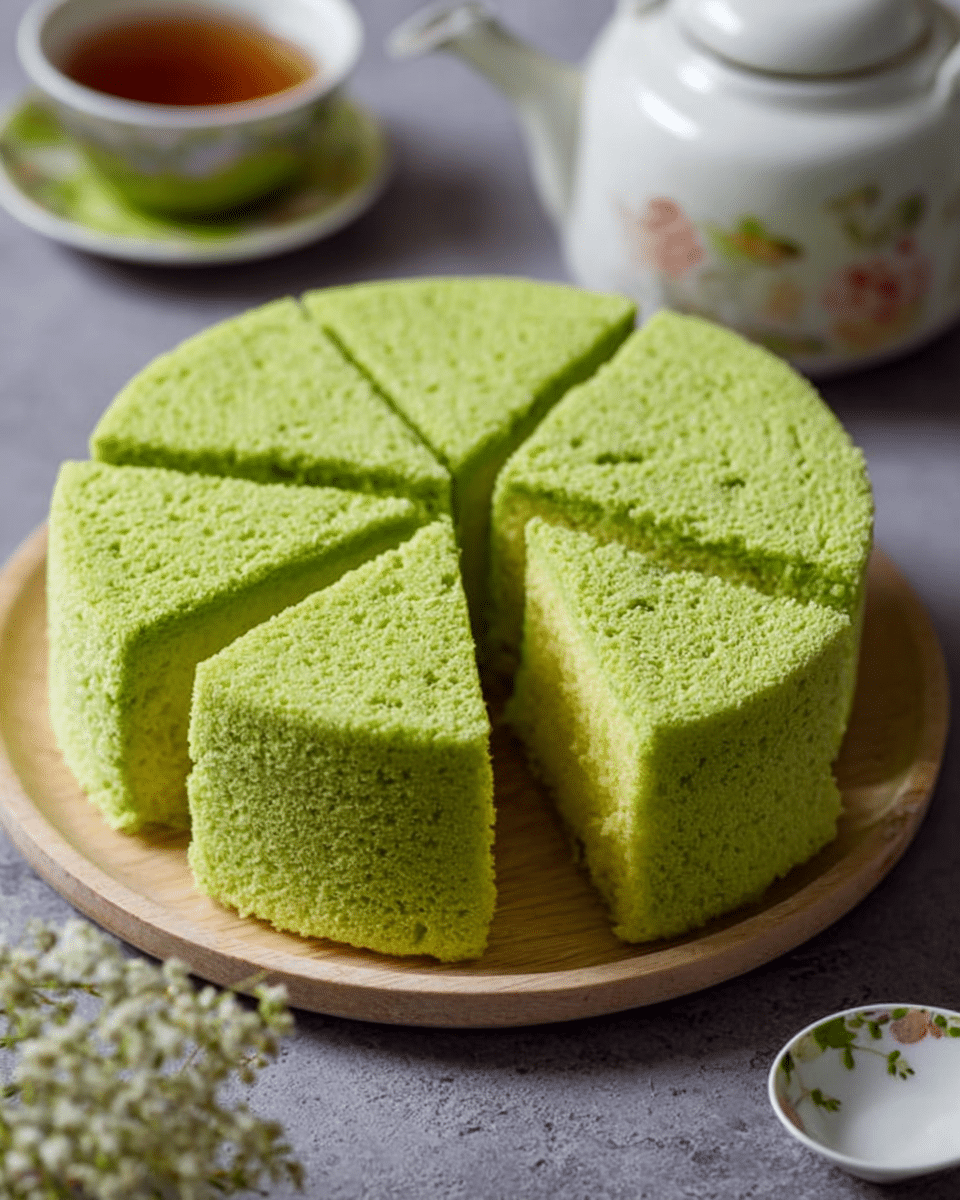This Steamed Pandan Sponge Cake is a delicate and light dessert that is both fragrant and flavorful, with the unique aroma of pandan blending perfectly with the soft, airy texture of the cake.
Perfect for any occasion, this cake pairs wonderfully with a cup of tea or as a light end to a meal. The coconut milk adds richness, while the pandan paste provides an exotic touch, making this treat a must-try for lovers of Asian-inspired desserts.
Full recipe:
Ingredients:
-
4 large eggs, room temperature
-
120g cake flour
-
100g sugar
-
1 tsp pandan paste or pandan extract
-
1/2 tsp vanilla extract
-
1/2 tsp baking powder
-
1/4 tsp salt
-
50g vegetable oil
-
50ml coconut milk
-
100ml water
Directions:
-
Grease and line a 7-inch round cake pan and set aside. Prepare a steamer and bring water to a boil.
-
In a mixing bowl, whisk together the eggs and sugar until fluffy and pale in color, about 5 minutes.
-
Add pandan paste (or extract) and vanilla extract, continuing to whisk.
-
Sift together the cake flour, baking powder, and salt in a separate bowl. Gradually add the dry ingredients to the egg mixture and fold gently until well combined.
-
In a small bowl, mix the coconut milk and vegetable oil together. Slowly pour this into the batter, folding to incorporate.
-
Add the water to the mixture, ensuring the batter is smooth and well-combined.
-
Pour the batter into the prepared cake pan and smooth the top with a spatula.
-
Place the cake pan in the steamer, cover, and steam over medium heat for about 30-40 minutes, or until a toothpick inserted comes out clean.
-
Let the cake cool for 10 minutes before removing it from the pan.
Prep Time: 15 minutes
Cooking Time: 40 minutes
Total Time: 55 minutes
Kcal: 220 kcal per serving
Servings: 6 servings
Understanding the Ingredients
The ingredients required for this steamed pandan sponge cake are deceptively simple. You’ll need eggs, sugar, cake flour, and pandan essence or extract. Each ingredient plays a vital role in the outcome of the cake:
-
Eggs are the primary structure builders in this cake. They must be beaten thoroughly to achieve the desired fluffy texture.
-
Sugar adds sweetness and also helps in the aeration process when beaten with eggs.
-
Cake Flour is preferred because it’s finer than all-purpose flour, ensuring a tender crumb and light texture.
-
Pandan Essence is what gives the cake its signature flavor and color. The green hue and distinct fragrance of pandan are what make this cake special. If you can’t find pandan essence, you can use pandan extract, though it may result in a slightly different color.
The Steaming Process: Key to Fluffiness
The steamer plays an integral role in making this cake. The gentle steam ensures that the cake rises gradually and evenly. If you’re unfamiliar with steaming cakes, here’s a breakdown of why it works so well:
Steaming helps the batter cook slowly, giving it time to expand and rise without the crust hardening, which often happens in a hot oven. When steaming, the texture is not only softer but also moister than a baked cake. However, timing and temperature control are crucial. If you steam the cake at too high a heat, it might overcook, causing it to collapse. Steaming at a medium heat, with the lid slightly open to allow the escape of some steam, ensures that the cake rises evenly, and its top forms a beautiful dome.
Achieving the Perfect Texture
One of the most important aspects of this recipe is beating the eggs and sugar to the proper consistency. To achieve the perfect spongy texture, you must ensure that the batter reaches the “ribbon stage.” At this stage, when you lift the whisk, the batter should fall in a thick ribbon-like pattern and stay visible for a while before sinking back into the rest of the batter. If the batter is not beaten to this point, the cake may turn out dense and heavy, which is the last thing you want in a sponge cake.
When folding in the flour mixture, it is important to be gentle. Over-mixing or deflating the batter at this stage can result in a less airy cake. Folding the flour gently ensures that the batter maintains its lightness and airiness.
Steaming Tips for Success
Here are some tips to ensure your pandan sponge cake turns out perfectly:
-
Room Temperature Eggs: Make sure your eggs are at room temperature. Cold eggs take longer to whip, and you may not achieve the desired thick, creamy consistency.
-
Ready Steamer: Prepare your steamer beforehand and ensure the water is at a gentle rolling boil before you begin whipping your eggs and sugar. It’s important to have the steamer ready as soon as the batter is done.
-
Gentle Folding: After mixing in the flour, fold the ingredients gently to avoid deflating the air you’ve just incorporated.
-
Steaming Temperature: Keep the heat at medium. Too high of a temperature will cause the cake to rise too quickly, while too low won’t allow the cake to rise enough.
-
Lid Slightly Open: Leaving the steamer lid slightly ajar helps prevent condensation from dripping onto the cake, which can affect its texture.
-
Wait Before Unmolding: After steaming, allow the cake to cool for at least 5 minutes before removing it from the steamer. This helps prevent it from collapsing.
-
Unmold Gently: Let the cake cool completely before removing it from the pan to avoid any structural issues.
How to Serve and Store Steamed Pandan Sponge Cake
This cake is incredibly versatile. It can be served as is, with a cup of tea or coffee, or used as a base for other layered cakes. You can also top it with fruits, whipped cream, or even layer it with other fillings. The subtle pandan flavor pairs well with a variety of toppings.
To store steamed pandan sponge cake, make sure it is completely cooled. Wrap it in plastic wrap and store it at room temperature for up to 3 days. For longer storage, you can freeze the cake. Simply wrap it well in plastic wrap, place it in a freezer bag, and store it in the freezer for up to one month. When ready to serve, thaw it in the fridge overnight, or steam it directly from frozen until heated through.
Troubleshooting Common Issues
Even with a simple recipe like this, there can be some common issues you might encounter:
-
Cake Collapsing After Steaming: This could happen if the cake wasn’t steamed long enough or at the right temperature. Ensure that the steamer is set to medium heat, and that the cake has enough time to rise gradually.
-
Dense Texture: This is most likely due to under-beating the eggs and sugar or over-folding the batter after adding the flour. Make sure to beat the eggs to the ribbon stage and handle the batter gently.
-
Uneven Rise: Make sure to prepare the batter evenly and ensure there are no large air pockets before steaming. You can do this by running a skewer around the batter to pop any large bubbles.
Conclusion
Steamed Pandan Sponge Cake is a beautiful dessert that combines simplicity with flavor. It’s a light and fluffy treat that’s easy to make with minimal ingredients but yields incredible results. With its subtle sweetness and the aromatic fragrance of pandan, this cake makes a fantastic dessert or a base for more elaborate creations. Whether you’re new to steaming cakes or have made them before, this recipe provides a wonderful opportunity to master the art of steaming, achieving a spongy texture without any added oils or chemical leaveners. Give it a try, and enjoy the soft, delicate flavors of this Asian-inspired treat!






